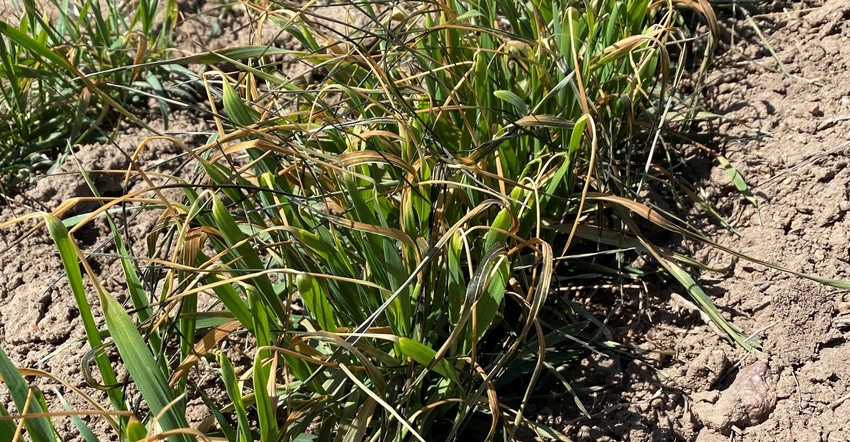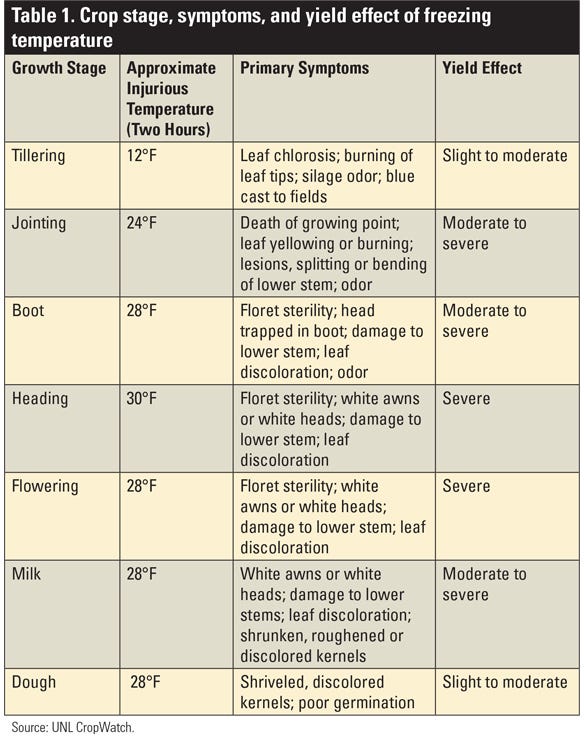April 16, 2020

Winter wheat development is on schedule across Nebraska. This is a good thing since some level of freeze damage occurs almost every year after the wheat breaks dormancy. Wheat that responds too early to warming temperatures with growth is at greater risk of injury from freezing temperatures.
On the morning of March 20, temperatures approached 0 degrees F across much of the wheat-growing region in Nebraska. A low temperature of 3 degrees was recorded in Sidney. Fortunately, wheat in 2020 had been slow to emerge from dormancy because of cool temperatures and was estimated to be near a 3 on the Feekes growth scale.
Given that most of Nebraska's winter wheat still is in the tillering stage and has not yet jointed, the effect of previous and coming freeze events is expected to be minor with little to no impact on the crop yield (Table 1).

As the wheat further develops and begins jointing, it still is able to tolerate temperatures in the mid- to upper 20s with no significant impact on yield apart from the cosmetic damage that may be observed.
Near the crop canopy and soil surface, a microclimate exists that may help alleviate temperature fluctuations. While the air temperature may drop and be low for several hours at a weather station, the actual microclimate of the crop may be several degrees warmer and create a "cushion" of protection to help moderate temperature swings. Factors besides air temperature affecting the potential for damage include:
Crop condition. The advanced growth stage increases winter injury. On the other hand, winter wheat stands that are poor or thin have less of a microclimate, and that makes the plants more susceptible to freeze injury.
Soil moisture. Generally, if the topsoil is moist, it helps limit soil temperature changes. Several years ago where there was a hard freeze in the Republican Valley in June, the cultivated corn with dry topsoil suffered significantly more damage than the noncultivated corn.
Duration of the chill. Most charts and tables that reference freeze injury in wheat require the temperatures to maintain for a period of two hours' duration. The wheat crop's microclimate can reduce the amount of time the crop is exposed to damaging temperatures.
The many factors influencing freeze injury to wheat — plant growth stage, plant moisture content and duration of exposure — often make it difficult to predict the extent of injury too quickly. This is complicated further by differences in elevation and topography among wheat fields and between the fields and official weather stations.
It is not unusual, for instance, for wheat growers to report markedly lower temperatures than are recorded at the nearest official weather station. Areas that may have been particularly susceptible to the temperatures are low field areas, thin stands and dry soil.
Winter wheat is most susceptible to freeze injury just after heading. This is when the head contains the greatest moisture content and has little protection from the plant. In 1981, Red Willow County (McCook) experienced low temperatures May 9-10 and suffered the greatest wheat loss for the state that year.
Winter wheat had just headed when temperatures dropped to 28 degrees F and slowly warmed to 37 degrees F over four hours. Decatur County, Kan., which adjoins Red Willow County, suffered the greatest loss in that state.
Typically, it takes at least two hours at a given low temperature to cause injury. The longer the cold temperatures persist, the greater the chance of injury. As the wheat continues to progress and develop, it becomes more vulnerable to freeze events and potential impacts on yield.
Remember it takes several warm days (a week or more, depending on temperatures) after a freeze before an accurate determination of injury can be made. Therefore, patience is required before deciding if the crop can be salvaged. Freeze damage can be observed by finding the developing head within the stem to check for irregularities.
Overall, remember that it is typical for winter wheat to experience freeze damage at some point each spring because of fluctuating weather patterns in Nebraska. However, wheat is a resilient crop and most varieties have been bred to handle the unique environment of Nebraska.
Give the wheat a few days to recover before accessing the level of injury. If you suspect yield potential has been reduced, contact your crop insurance agent so the crop can be properly adjusted. Also, check with the Farm Service Agency before making any changes.
Creech is a Nebraska Extension dryland cropping systems specialist, and Klein is an emeritus professor at the University of Nebraska-Lincoln.
Source: UNL CropWatch, which is solely responsible for the information provided and is wholly owned by the source. Informa Business Media and all its subsidiaries are not responsible for any of the content contained in this information asset.
You May Also Like




